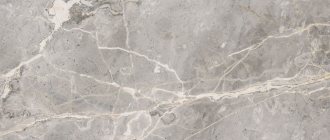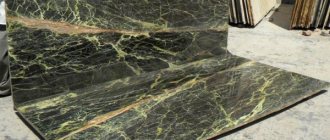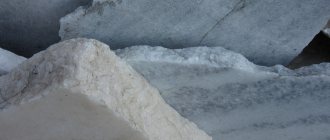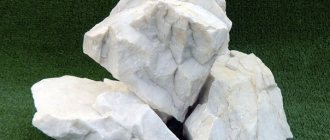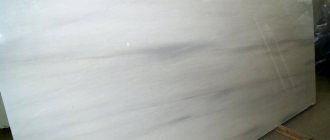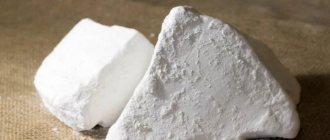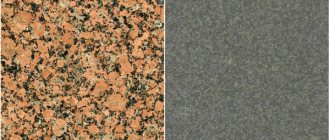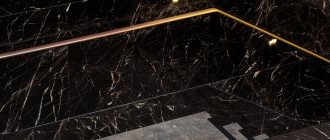Few materials have as many different uses as marble. This stone has a number of useful properties that make it indispensable in industry and art. It is easy to cut and polished with special tools; it has a unique aesthetics. Marble products are popular all over the world, among all segments of the population. This article talks about the origin of marble and its properties, the extraction and use of its varieties in many areas of life.
Stone in history
The name was coined by the ancient Greeks: the mineral mined in the country was “shiny white.”
This is how “marble” is translated from the ancient Greek:
- Ancient Greek sculpture and religious buildings (for example, the temple of the goddess Aphrodite) have become world heritage. They still shine today.
- The ease of processing marble stone contributed to the development of glyptics: carving miniature images into stone. Such cameos and intaglios are kept today in private and public collections around the world. They are also in the Hermitage.
Later, the stone from Carrara captured the imagination of the great Michelangelo. His works are not inferior to ancient examples.
The rulers of the Italian principalities of the Middle Ages decorated the mansions with marble slabs. Today, the “marble lace” of the palaces of Tuscany or Venice is just as magnificent.
Light stone is perhaps the main building material in Muslim architecture. The most striking masterpiece is the Indian Taj Mahal made of white and pink marble. It is accompanied by a romantic love story. The monuments of Samarkand, Bukhara and other cities of Central Asia are no less beautiful.
Marble Palace in St. Petersburg
What is
Marble stone is a coarse-grained rock. This is the final stage of metamorphism of sedimentary carbonates.
That is, the origin of marble is metamorphic. The process took place at average temperatures and pressure. As a result, the sand grains of calcium and magnesium carbonate became larger.
This is how fine-, medium- and coarse-grained rocks were formed. The use of the stone depends on the grain size. Sculptors, for example, need fine-grained marble.
Marble comes in different colors. Some of its types are endowed with natural shine. But after polishing everything shines.
Sometimes the stone is translucent. Such specimens are dismantled by sculptors and decorators.
Scope of application
The presence of calcium carbonate in the composition of this rock provides both flexibility and strength, which is why it is widely used in construction, in the manufacture of tombstones and monuments. Marble is used to make sculptures, bathtubs, vases of various sizes, souvenirs and other products that will never go out of fashion and will last for a very long time.
This is an amazingly beautiful stone that comes in different colors and has a unique pattern texture. The use of marble in creating unique masterpieces of classical art is due to this trait. The great Michelangelo used marble for cladding, decoration and sculptures.
The unique transparency of marble, which professionals often call relative, allows for bizarre plays of light and shadow to be visible on the treated surface of sculptures: sometimes it seems that a petrified masterpiece can come to life at any time. This stone has no equal in the art of sculpture. The high wear resistance for which marble is famous is invaluable for people who have the good fortune to contemplate real masterpieces for many centuries.
The use of marble in the construction industry is not limited to tiling and creating stunning staircases, walls and garden structures. It is actively used in the ferrous metallurgical industry when open-hearth furnaces are made. Marble chips are used in glass making and even as agricultural fertilizers.
Where is it mined?
Stone deposits are developed in many countries: Italy, Greece, Norway, France, Germany, Ukraine, USA, Cuba, Uzbekistan.
In Russia these are the Urals, Khakassia, the Far East, and the Sayan Mountains.
Almost every mine supplies its own varieties of marble:
- Italy is the source of elite Carrara marble. The quarries are located in Tuscany, the annual production does not exceed a ton.
- France. The country produces a pink-yellow stone with barely visible veins (“Rose-fose”). Norman red marble is prized, recognizable by its red-brown shades with white veins.
- Russia supplies the domestic and world markets with white (Ufaley) marble from the Urals and colored Sayan raw materials. Its almost five thousand quarries contain more than a billion cubic meters of rock.
- Ireland, Central Asia – sources of elite green stone.
Germany is developing deposits of several types of marble:
- More often it is a light gray stone with white veins.
- Bavaria is famous for its red (or Jurassic) marble. The stone is prized for its rich red color and intricate white or green veining.
- The graphenstein variety looks noble. The stone is identified by its bright, clear pattern and moiré tint - gray, blue or white. These features appear after polishing.
A special situation in Greece. The Paros (Cyclida archipelago) and Pentelikon (outskirts of Athens) deposits have been developed since Antiquity. Today, their raw materials are registered with the state and are used only for the restoration of monuments.
Marble is mined by quarrying. Monolithic blocks are produced using stone-cutting and impact-cutting machines, and rope saws.
Difficulty of use
When using natural stone in construction, certain circumstances should be taken into account. They may require additional investment of funds and time during the construction process.
Thus, the fastening of columns, porticoes, balustrades and fences is carried out using steel reinforcement, and the seams are sealed with special compounds. Marble tiles and flooring are also laid using a special method, which avoids the appearance of unnecessary patterns. Creating marble cladding requires ventilation space and additional supports. This is necessary so that the cladding does not crumble during operation.
Physico-chemical characteristics
To a chemist, marble is almost pure calcium carbonate. The composition of the rock is complemented by chalcedony, feldspar, quartz, hematite, and other impurities. Their relationship creates the color and pattern of the stone.
| Rock type | Metamorphic rock |
| Color | White, grey, yellowish, green, red, black |
| Texture 2 | banded massive spotted |
| Structure 2 | granoblastic heteroblastic fine-grained medium-grained coarse-grained |
| origin of name | lat. marmor, name from Greek. Μάρμαρος – luminous stone |
Place of Birth
Marble sites are found in various parts of the Earth. Depending on the territorial location, the mineral is divided into groups. In the Alps there is a deposit of the Carrara gem, the Sayan mineral is mined in the Sayans, a Jurassic specimen is found in Bavaria, and a mine of Ufaley marble is located in the Urals.
White rock ore is mined in Greece, Norway and France. Rich deposits are known in America, Africa and Cuba. Crimea, Transcarpathia, Donbass are rich in natural resources. In Uzbekistan, high-quality marble with unique colors is mined.
Varieties
Marble stone of different grades is mined on the planet:
- White. Free from impurities, a sculptural and decorative type of stone.
- Black. It is created by an admixture of bitumen and graphite.
- Red. It comes in varying degrees of saturation - from purple to soft pink, sometimes “rusty”. This is determined by the amount of iron oxide in the composition.
- Blue. The tint is created by highly dispersed iron sulfide. Shades up to inky or almost black are possible. Rare expensive variety.
- Green. The tint is due to chlorite, epidote, and other iron-containing silicates. Rare, very expensive material.
- Yellow. It is created by impurity carbonates and iron hydroxides. There are ocher, orange, and brown shades.
- Grey. Coarse-grained stone in a full range of shades. You come across raw materials with inclusions that impart a yellowish or pinkish tint. The most durable in its family. Unlike other types, it can be cut.
- Beige. The shades and their intensity are created by limonite and manganese. Durable variety, suitable even as a floor covering.
- Brown. The base is complemented by iron, limonite and manganese. The most popular color is chocolate.
Dolomite marble stands apart. This rock is formed by the recrystallization of dolomite, additionally receiving magnesium.
Mineral mining
On our planet there are enough deposits rich in rock deposits. The most famous and significant of them is considered a natural accumulation of minerals located near the Italian city of Carrara in Tuscany. This marble deposit is famous for the presence of white stones. In Greece there are deposits of Parian stone, the structure of which is distinguished by the presence of a yellow tint. The mineral is also mined in France, Norway, and Cuba. In the USA, the marble deposit is located in the Appalachians, in South Africa - in Natal.
There are also accumulations of rock on the territory of Russia, but in insignificant quantities. We are talking about deposits located in the depths of the Eastern Urals, in the south of Yakutia, in the Crimea, the Irkutsk Territory and on the territory of the Kola Peninsula.
The following countries can boast of marble deposits:
- Armenia. Agrevansk, Ijevan and Khorvirab deposits are rich in brown, pink and black samples.
- Georgia. In the Molitskoye and Salietskoye deposits, stones of red and gray colors are mined.
- Uzbekistan. In this country there is Gazgan marble in cream and pink shades, gray and pink Aman-Kutan marble, and white Malguzar marble.
- Ukraine. There, marble stone lies in the lands of the Transcarpathian and Donetsk regions.
At the same time, the largest amount of shining stone (as marble is sometimes called, given its characteristics and appearance) is extracted from the depths of Turkey.
Medicinal properties
The chemical composition of marble allows this majestic and noble stone to be used to influence the main organs on which normal human life depends. The mineral has the ability to have a beneficial effect on the respiratory and cardiovascular systems, and the functioning of the gastrointestinal tract. To normalize breathing, beads or a pendant made of valuable rock are placed around the neck.
The use of the material in stabilizing the psychoneurological state of a person makes it an integral part of the treatment with the beneficial properties of stones (lithotherapy). In this case, the properties of marble allow you to get rid of insomnia, nervousness, nightmare visions, and all kinds of stress. If a person has increased excitability of the nervous system, he is advised to wear bracelets or rings. You can use both types of products at the same time.
Where is it used?
Stone processing is not as difficult as, for example, granite. It is easy to cut, polish, grind. It practically does not absorb moisture and shines after polishing. These properties of marble have determined the areas of application in modern conditions.
Construction
As before, marble stone is popular as a building material:
- The walls are decorated with slabs and the floors are lined.
- They are used to line pools, fountains, and ponds.
- They grind countertops, mantelpieces, window sills, and plumbing fixtures (washbasins, bathtubs).
Marble countertops - They create stairs, columns, and other large elements of premises.
Marble chips are used for wall cladding, mosaic panels, textured plasters, and as a concrete filler.
Popularity increases the versatility of the raw material. Stone of any color is organic against the background of wood, ceramics, and drywall. Even plastic gets along with it.
Jewelry
Even the best varieties of stone are classified as ornamental. Almost all marble is well ground and polished, but it is heavy and cannot be cut.
Marble jewelry
Therefore, small beads, pendants, and inserts for rings are often made from it.
Decor
The second most popular (after construction) area of use of stone.
Marble furniture has been a popular trend in home decoration for many years.
It is complemented by large plastic works: vases, bowls, indoor sculptures.
Marble vases
The properties of marble make it a universal material for stone carvers.
They create everything from miniature figurines, photo frames, esoteric assortments to large vases, tables, chests of drawers.
Other areas
Marble boards are in demand by the electrical industry, and stone flour is taken by farmers.
A ritual assortment (boards, monuments, tombstones) is made from marble.
However, the modern microclimate of megacities is not suitable for delicate stone. Therefore, marble sculpture and other exterior products need regular cleaning from soot and other contaminants.
Compatibility with names and zodiac signs
The astrological properties of marble favor all representatives of the zodiac circle. However, signs protected by the water element should count on the main help of the mineral.
(“+++” – the stone fits perfectly, “+” – can be worn, “-” – is strictly contraindicated):
| Zodiac sign | Compatibility |
| Aries | + |
| Taurus | + |
| Twins | + |
| Cancer | +++ |
| a lion | + |
| Virgo | + |
| Scales | + |
| Scorpion | +++ |
| Sagittarius | + |
| Capricorn | + |
| Aquarius | + |
| Fish | +++ |
- Pisces is a zodiac sign whose energy of nature, with the help of marble, protects from betrayal and disappointment in love;
- Cancer - this sign, when exposed to vibrations of the mineral, unerringly chooses a life partner, resolves conflict situations in the family;
- Scorpio - let him count on the fact that the house will be reliably protected from anger, negativity and misfortune if there is a marble figurine or vase in the home.
Most people know what meaning their own name has for a person. The compatibility of the amulet with the name partly influences this or that choice, which helps in building one’s own destiny. List of names compatible with marble of some shades:
- White stone is compatible with every name.
- Green “impresses” Vitaly, Evgeniy, and Valentina.
- Red is the color of Arkady, Semyon, Alina.
- The pink shade suits Anastasia and Eva.
- Yellow is the color of Denis, Mikhail, Larisa.
- Blue and light blue are the tones for Maria, Leonid, Olga, Nina.
It is known from the chronicles that every family, whether living in poverty or in prosperity, tried to acquire a marble amulet. This mineral adapts to each personality and helps regardless of the name and affiliation with a particular zodiac sign.
How to identify the origin of marble
Under the guise of natural marble, similar materials are often offered, for example, marbled limestone (calcite).
It is easy to distinguish the original:
- Fossilized plant remains, voids, and air bubbles are present in calcite, but not in marble.
- Calcite has a fine-grained structure.
- Marble can show through deep into the stone, calcite never does.
You can also distinguish natural stone from artificial:
- Resins and acrylic dyes as the main component make the man-made material too smooth and bright.
- It never shines through.
- Heats up faster.
- Much cheaper than natural ones.
- Natural marble dissolves rapidly with hydrogen chloride, while artificial marble does not react.
The last property can be checked on a piece of raw material.
Advantages
Natural marble has always been considered a sign of wealth. Master builders used it not only because of its beauty. This material has a number of advantages.
These include:
- strength – certain types of marble are able to withstand increased mechanical load, significant temperature changes and exposure to moisture;
- durability - it is not only easy to process, but also to restore;
- hygiene – marble is an environmentally friendly material;
- beauty – a rich range of colors, each individual slab has a unique picturesque design.
Artificial marble
The high cost of natural stone prompted the creation of artificial marble.
The main component of this material is polyester resins. They are supplemented with mineral fillers, dyes, and acrylic resins.
The technology practically reproduces the process by which stone is formed in nature.
Specific proportions depend on the purpose and price segment. For example, in a budget version, crushed quartz stone chips, pebbles, concrete-cement mixtures, and colored sand are used.
But in any case, the composite is durable, with almost zero wear.
Additional advantages:
- Homogeneous structure, due to which the material does not exfoliate.
- Zero flammability and electrical conductivity.
- Immunity to rust.
- Resistance to any cleaning compounds.
Man-made marble is in demand in various areas: accessories for kitchens, bathrooms, and basement decoration of buildings.
The stone can be made even at home.
How to care
In order for marble floors, plumbing fixtures, and decorative items to last longer, they need to be looked after:
- Dirt is removed only with mild detergents (preferably baby soap) and the same napkins. Abrasives, even a rough brush, can scratch the marble surface.
- After washing, the products are polished with suede and special polishing agents - indicating “for marble”.
- Grease stains are removed with white spirit.
- Marble that is in the kitchen, bathroom or outdoor area will develop mold. Remove it with a low concentration chlorine solution.
- Products are protected from falls, impacts, and other strong impacts.
Acids or cleaning agents with high concentrations are guaranteed to damage natural marble.
It is better to clean the products regularly to avoid heavy contamination.
Price
Manufacturers and prospectors offer a wide range of stone products and collection materials (price / rub.):
- flat bowl (32x27x4.5 cm; Armenia) – 78,000;
- figurine of a polar bear (7.5x4.5x3 cm; Russia) – 3,460;
- countertop – 2,500 – 12,800;
- staircase – 3,100 – 7,500 (m)
- pendant (diameter 4 cm, frame – copper) – 520;
- bracelet – 620;
- ball (7.2 cm; Ural) – 1,500.
Marble vase
You can buy vases, a collection of figurines, and other stone-cutting products made from marble.
Magic of stone
In the past, marble was given different meanings by residents of different countries:
- The Romans put first priority on the stone’s ability to repel dark power and witchcraft.
- The inhabitants of Ancient Greece revered marble as a love stone.
- The Indians considered him a companion of good.
Therefore, the Roman nobility built mansions made of marble, unmarried Greek women acquired a ring with a stone, and Indian families acquired some kind of thing made of marble.
Today the list of magical properties of marble has been expanded:
- The stone is able to protect against rash actions and ill-considered words.
- Gives strength and calmness during “nervous” work.
- Protects from danger outside the home.
- It will help you find your soul mate, protect you from jealousy, and strengthen marriage or informal ties.
However, using marble as a love spell is fraught with trouble.
- This is a real family talisman: the magic of the stone will improve relations between household members of different generations, protect the house from uninvited guests and ill-wishers.
- Shows the path to prosperity.
- Will help your romantic dream come true.
- It is recommended to be worn by a woman who wants to become a mother and give birth to a healthy child.
Marble is a talisman for teachers, doctors, military personnel, rescuers, and police officers.
The magic of the stone will manifest itself when wearing a ring, pendant, or bracelet.
Magic properties
Most people know what the stone looks like, however, many do not know how strong the mineral is as an esoteric attribute.
Ancient occult knowledge tells how important the energy of minerals is in solving many everyday problems. The magical power of the crystal is evidenced by how widely the gem was used in ancient times to this day.
Ancient people appreciated the magic stone; marble was not in vain a symbol of love. Patterned slabs made of rock adorn the majestic buildings dedicated to Aphrodite, which have become architectural monuments and national treasures. Modern practicing magicians suggest using gem talismans to maintain harmony and warmth in relationships.
The main magical properties of marble:
- maintaining sincere feelings and affection of love partners;
- eliminating jealousy and mistrust in relationships;
- strengthening family ties;
- establishing relationships among household members in different age categories;
- protecting the family hearth, ridding the home (house) of negative energy;
- protection from troubles, the evil eye, and illnesses of the whole family.
With the help of marble, magical rituals are performed that help improve the quality of life. In some countries, there are traditions leading to the use of gems to solve most vital problems. Every family, regardless of social status and financial situation, has a magical attribute made from natural material.
A marble talisman protects people of various professions, but is most useful for those who have to take risks. These may be military professions or law enforcement agencies. Doctors and sellers receive protection from the amulet from erroneous actions and unfriendly visitors. Teachers are given patience and assistance in discovering knowledge, and a passion for science.
Important! Gems should not be used to attract love against the will of a person. These actions can lead to serious, sometimes even irreversible consequences.
Therapeutic effect
Lithotherapists have discovered a whole range of health benefits in marble:
- The stone helps improve digestion and the functioning of the gastrointestinal tract in general.
- Heals the heart and respiratory organs.
- Normalizes blood pressure.
- Clears blood vessels of cholesterol deposits.
- Strengthens the nerves, calms the psyche, helps keep aggression, the tendency to violence, and other similar emotions under control.
- Relieves unmotivated anxiety, panic attacks, and excitement.
- Improves sleep quality, especially with chronic insomnia.
- Promotes concentration, strengthens attentiveness.
- Increases the absorption of medications.
The healing effect of marble is more pronounced when wearing pendants or beads.
Marble rollers or balls are used as proven massage tools. They neutralize radiculitis, joint pain, and increased sweating.
